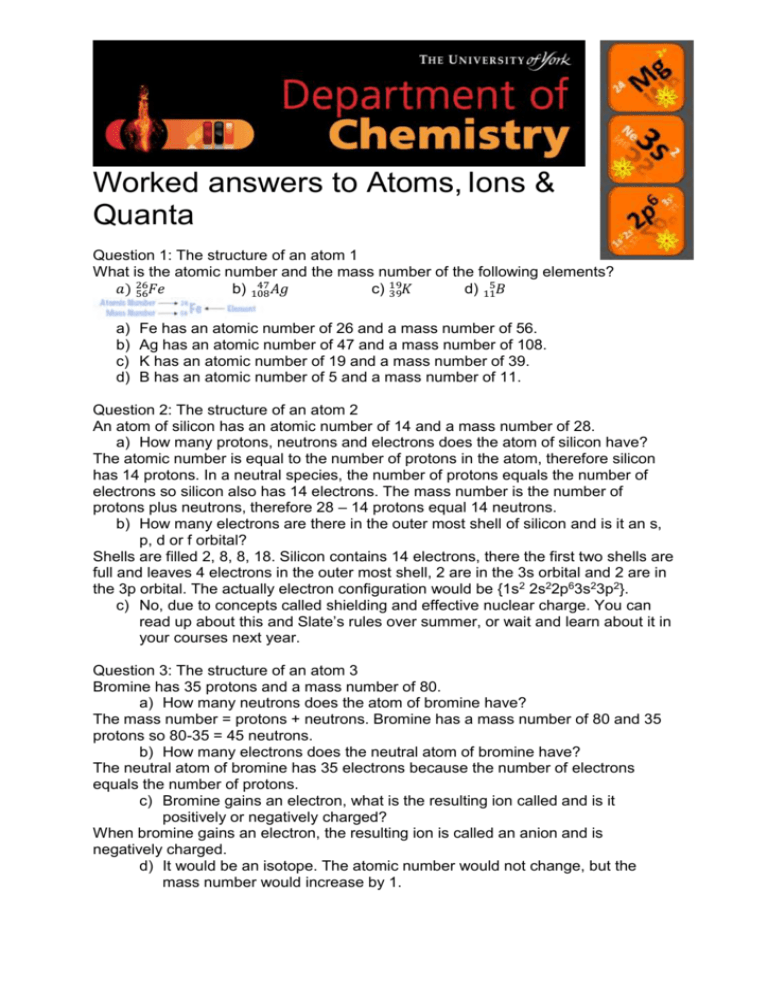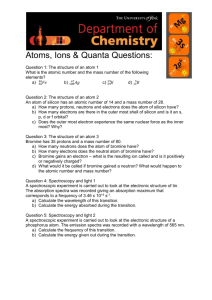Worked answers to Atoms, Ions & Quanta Question 1: The structure
advertisement

Worked answers to Atoms, Ions &
Quanta
Question 1: The structure of an atom 1
What is the atomic number and the mass number of the following elements?
47
𝑎) 26
b) 108
𝐴𝑔
c) 19
d) 115𝐵
39𝐾
56𝐹𝑒
a)
b)
c)
d)
Fe has an atomic number of 26 and a mass number of 56.
Ag has an atomic number of 47 and a mass number of 108.
K has an atomic number of 19 and a mass number of 39.
B has an atomic number of 5 and a mass number of 11.
Question 2: The structure of an atom 2
An atom of silicon has an atomic number of 14 and a mass number of 28.
a) How many protons, neutrons and electrons does the atom of silicon have?
The atomic number is equal to the number of protons in the atom, therefore silicon
has 14 protons. In a neutral species, the number of protons equals the number of
electrons so silicon also has 14 electrons. The mass number is the number of
protons plus neutrons, therefore 28 – 14 protons equal 14 neutrons.
b) How many electrons are there in the outer most shell of silicon and is it an s,
p, d or f orbital?
Shells are filled 2, 8, 8, 18. Silicon contains 14 electrons, there the first two shells are
full and leaves 4 electrons in the outer most shell, 2 are in the 3s orbital and 2 are in
the 3p orbital. The actually electron configuration would be {1s2 2s22p63s23p2}.
c) No, due to concepts called shielding and effective nuclear charge. You can
read up about this and Slate’s rules over summer, or wait and learn about it in
your courses next year.
Question 3: The structure of an atom 3
Bromine has 35 protons and a mass number of 80.
a) How many neutrons does the atom of bromine have?
The mass number = protons + neutrons. Bromine has a mass number of 80 and 35
protons so 80-35 = 45 neutrons.
b) How many electrons does the neutral atom of bromine have?
The neutral atom of bromine has 35 electrons because the number of electrons
equals the number of protons.
c) Bromine gains an electron, what is the resulting ion called and is it
positively or negatively charged?
When bromine gains an electron, the resulting ion is called an anion and is
negatively charged.
d) It would be an isotope. The atomic number would not change, but the
mass number would increase by 1.
Question 4: Spectroscopy and light 1
A spectroscopic experiment is carried out to look at the electronic structure of tin.
The absorption spectra was recorded giving an absorption maximum that
corresponds to a frequency of 3.46 x 1014 s-1.
a) Calculate the wavelength of this transition.
λ=c/v
λ = 2.998 x 108 m s-1 / 3.46 x 1014 s-1
λ = 8.665 x 10-7 m
1nm = 10-9 m
λ = 866.5 nm
b) Calculate the energy absorbed during the transition.
E = hv
E = 6.626 x 10-34 J s x 3.46 x 1014 s-1
E = 2.29 x 10-19 J
Question 5: Spectroscopy and light 2
A spectroscopic experiment is carried out to look at the electronic structure of a
phosphorus atom. The emission spectra was recorded with a wavelength of 565 nm.
a) Calculate the frequency of this transition.
v=c/λ
565 nm = 565 x 10-9 m
v = 2.998 x 108 m s-1 / 565 x 10-9 m
v = 5.306 x 1014 s-1
b) Calculate the energy given out during the transition.
E = hv
E = 6.626 x 10-34 J s x 5.306 x 1014 s-1
E = 3.52 x 1019 J







